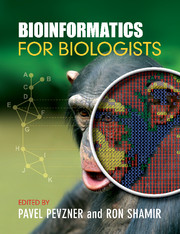Book contents
- Frontmatter
- Contents
- Extended contents
- Preface
- Acknowledgments
- Editors and contributors
- A computational micro primer
- PART I Genomes
- PART II Gene Transcription and Regulation
- 6 How do replication and transcription change genomes?
- 7 Modeling regulatory motifs
- 8 How does the influenza virus jump from animals to humans?
- PART III Evolution
- PART IV Phylogeny
- PART V Regulatory Networks
- REFERENCES
- Glossary
- Index
6 - How do replication and transcription change genomes?
from PART II - Gene Transcription and Regulation
Published online by Cambridge University Press: 05 June 2012
- Frontmatter
- Contents
- Extended contents
- Preface
- Acknowledgments
- Editors and contributors
- A computational micro primer
- PART I Genomes
- PART II Gene Transcription and Regulation
- 6 How do replication and transcription change genomes?
- 7 Modeling regulatory motifs
- 8 How does the influenza virus jump from animals to humans?
- PART III Evolution
- PART IV Phylogeny
- PART V Regulatory Networks
- REFERENCES
- Glossary
- Index
Summary
From the evolutionary standpoint, DNA replication and transcription are two fundamental processes enabling reliable passage of fitness advantages through generations (in DNA form) and manifestation of these advantages (in RNA form), respectively. Paradoxically, both of these basic mechanisms not only preserve genetic information but also apparently cause systematic genomic changes directly. Here, I show how genome-scale sequence analysis can help identify such effects, estimate their relative contributions, and find practical application (e.g. for predicting replication origins). Visualization of bioinformatics results is often the best way of connecting them to the underlying biological question and I describe the process of choosing the visual representation that would help compare different organisms, genomes, and chromosomes.
Introduction
A species' genome relies on faithful reproduction to reap the benefits of selection. The very fact that the “fine-tuned” genomes of previous generations carrying important fitness advantages can be preserved in the proliferating progeny is the basis of natural selection. That is how we currently understand evolution and life around us, and this grand scheme can operate only under stringent requirements for the precision with which DNA replicates. It is not surprising, therefore, that one observes higher replication fidelity in more complex organisms.
For the sake of clarity, however, we leave the “more complex organisms” aside for the duration of this chapter. The higher fidelity mentioned above results from many additional processes (including advanced repair) taking place in a cell besides replication.
Information
- Type
- Chapter
- Information
- Bioinformatics for Biologists , pp. 111 - 125Publisher: Cambridge University PressPrint publication year: 2011
